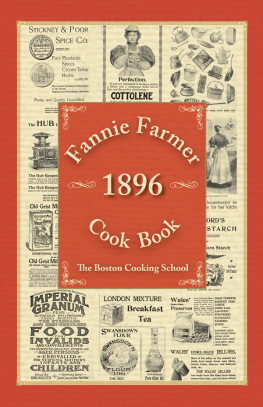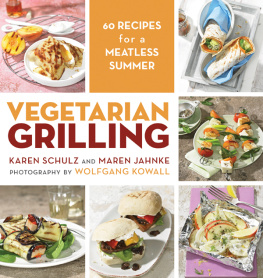Copyright 1896, 2011 by Fannie Merritt Farmer
All Rights Reserved. No part of this book may be reproduced in any manner without the express written consent of the publisher, except in the case of brief excerpts in critical reviews or articles. All inquiries should be addressed to Skyhorse Publishing, 307 West 36th Street, 11th Floor, New York, NY 10018.
Skyhorse Publishing books may be purchased in bulk at special discounts for sales promotion, corporate gifts, fund-raising, or educational purposes. Special editions can also be created to specifications. For details, contact the Special Sales Department, Skyhorse Publishing, 307 West 36th Street, 11th Floor, New York, NY 10018 or .
Skyhorse and Skyhorse Publishing are registered trademarks of Skyhorse Publishing, Inc., a Delaware corporation.
www.skyhorsepublishing.com
10 9 8 7 6 5 4 3 2
Library of Congress Cataloging-in-Publication Data is available on file.
ISBN: 978-1-61608-543-8
Printed in China
TO
MRS. WILLIAM B. SEWALL,
President of the Boston Cooking-School,
IN APPRECIATION OF HER HELPFUL ENCOURAGEMENT AND
UNTIRING EFFORTS IN PROMOTING THE WORK OF
SCIENTIFIC COOKERY , WHICH MEANS THE
ELEVATION OF THE HUMAN RACE ,
THIS BOOK IS AFFECTIONATELY DEDICATED
B Y THE A UTHOR .
Cookery means the knowledge of Medea and of Circe and of Helen and of the Queen of Sheba. It means the knowledge of all herbs and fruits and balms and spices, and all that is healing and sweet in the fields and groves and savory in meats. It means carefulness and inventiveness and willingness and readiness of appliances. It means the economy of your grandmothers and the science of the modern chemist; it means much testing and no wasting; it means English thoroughness and French art and Arabian hospitality; and, in fine, it means that you are to be perfectly and always ladiesloaf givers .R USKIN .
PREFACE.

B UT for life the universe were nothing; and all that has life requires nourishment.
With the progress of knowledge the needs of the human body have not been forgotten. During the last decade much time has been given by scientists to the study of foods and their dietetic value, and it is a subject which rightfully should demand much consideration from all. I certainly feel that the time is not far distant when a knowledge of the principles of diet will be an essential part of ones education. Then mankind will eat to live, will be able to do better mental and physical work, and disease will be less frequent.
At the earnest solicitation of educators, pupils, and friends, I have been urged to prepare this book, and I trust it may be a help to many who need its aid. It is my wish that it may not only be looked upon as a compilation of tried and tested recipes, but that it may awaken an interest through its condensed scientific knowledge which will lead to deeper thought and broader study of what to eat.
F. M. F.
TABLE OF CONTENTS.


CHAPTER I.
FOOD.
F OOD is anything which nourishes the body. Thirteen elements enter into the composition of the body: oxygen, 62 %; carbon, 21
%; carbon, 21 %; hydrogen, 10%; nitrogen, 3%; calcium, phosphorus, potassium, sulphur, chlorine, sodium, magnesium, iron, and fluorine the remaining 3%. Others are found occasionally, but, as their uses are unknown, will not be considered.
%; hydrogen, 10%; nitrogen, 3%; calcium, phosphorus, potassium, sulphur, chlorine, sodium, magnesium, iron, and fluorine the remaining 3%. Others are found occasionally, but, as their uses are unknown, will not be considered.
Food is necessary for growth, repair, and energy; therefore the elements composing the body must be found in the food. The thirteen elements named are formed into chemical compounds by the vegetable and animal kingdoms to support the highest order of being, man. All food must undergo chemical change after being taken into the body, before it can be utilized by the body; this is the office of the digestive system.
Food is classified as follows:

The chief office of proteids is to build and repair tissues. They can furnish energy, but at greater cost than carbohydrates, fats, and oils. They contain nitrogen, carbon, oxygen, hydrogen, and sulphur or phosphorus, and include all forms of animal foods (excepting fats and glycogen) and some vegetable foods. Examples: milk, cheese, eggs, meat, fish, cereals, peas, beans, and lentils. The principal constituent of proteid food is albumen. Albumen as found in food takes different names, but has the same chemical composition; as, albumen in eggs, fibrin in meat, casein in milk and cheese, vegetable casein or legumen in peas, beans, and lentils; and gluten in wheat. To this same class belongs gelatine.
The chief office of the carbohydrates is to furnish energy and maintain heat. They contain carbon, hydrogen, and oxygen, and include foods containing starch and sugar. Examples: vegetables, fruits, cereals, sugars, and gums.
The chief office of fats and oils is to store energy and heat to be used as needed, and constitute the adipose tissues of the body. Examples: butter, cream, fat of meat, fish, cereals, nuts, and the berry of the olive-tree.
The chief office of mineral matter is to furnish the necessary salts which are found in all animal and vegetable foods. Examples: sodium chloride (common salt); carbonates, sulphates and phosphates of sodium, potassium, and magnesium; besides calcium phosphates and iron.
Water constitutes about two-thirds the weight of the body, and is in all tissues and fluids; therefore its abundant use is necessary. One of the greatest errors in diet is neglect to take enough water; while it is found in all animal and vegetable food, the amount is insufficient.
CORRECT PROPORTIONS OF FOOD.
Age, sex, occupation, climate, and season must determine the diet of a person in normal condition.
Liquid food (milk or milk in preparation with the various prepared foods on the market) should constitute the diet of a child for the first eighteen months. After the teeth appear, by which time ferments have been developed for the digestion of starchy foods, entire wheat bread, baked potatoes, cereals, meat broths, and occasionally boiled eggs may be given. If mothers would use Dr. Johnsons Educators in place of the various sweet crackers, children would be as well pleased and better nourished; with a glass of milk they form a supper suited to the needs of little ones, and experience has shown children seldom tire of them. The diet should be gradually increased by the addition of cooked fruits, vegetables, and simple desserts; the third or fourth year fish and meat may be introduced, if given sparingly. Always avoid salted meats, coarse vegetables (beets, carrots, and turnips), cheese, fried food, pastry, rich desserts, confections, condiments, tea, coffee, and iced water. For school children the diet should be varied and abundant, constantly bearing in mind that this is a period of great mental and physical growth. Where children have broken down, supposedly from over-work, the cause has often been traced to impoverished diet. It must not be forgotten that digestive processes go on so rapidly that the stomach is soon emptied. Thanks to the institutor of the school luncheon-counter!






















 %; carbon, 21
%; carbon, 21